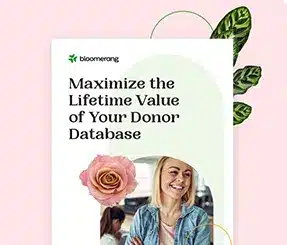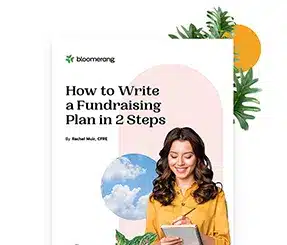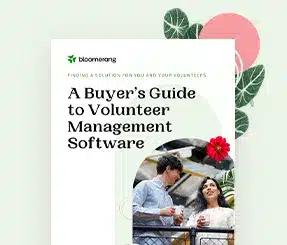[ASK AN EXPERT] Why Aren’t My Donor Meetings Turning Into Gifts?


Full Platform Overview Chat With Us



Full Platform Overview Chat With Us




Our Ask An Expert series features real questions answered by Claire Axelrad, J.D., CFRE, also known as Charity Clairity. Today’s question comes from a nonprofit employee who wants advice on how to turn major donor conversations into gifts:
Dear Charity Clairity,
“I’ve had several promising conversations with major donor prospects. They’re engaged, curious, and even emotional when we talk about our work. But then… nothing. No follow-up gift. No next steps. It feels like failure. I’m wondering—am I missing something in the ask? How do I artfully turn good conversations into real commitments?”
— Meetings, but No Movement
Dear Meetings, but No Movement,
First, the good news. You’re doing something many fundraisers never quite master: creating genuine, meaningful conversations with your donors. That emotional engagement is gold. It’s not even close to failure. It’s foundation.
It means your cause is landing in their hearts. But it can be frustrating – to both of you! — when those moments don’t lead anywhere tangible.
You’re not alone. This is one of the most common—and human—challenges in major gift fundraising. The reality is many donors won’t move forward unless they’re specifically invited to. They might walk away from a conversation inspired, but without clarity on what you want from them — and when. If you walk out thinking, “That went great,” but don’t end with a defined ask or next action, they may leave thinking, “That was lovely… maybe someday.”
You need to offer a clear, confident next step.
Here are three ways to shift from connection + confusion (around next steps) to concern = commitment (to a specific amount for a specific purpose):
It’s easy to wait, to keep building rapport, to want “just one more meeting” before asking. But here’s the truth: when you don’t ask, you leave your donor in limbo. They may wonder “What was the point of that conversation?” Or they may wonder if they were supposed to take the lead and offer to make a gift (even though they weren’t sure how much and when) – and, since they didn’t, maybe now you don’t like them?
It’s completely natural to hesitate when it comes time to make the ask—especially when a conversation is flowing, emotional, and human. You don’t want to disrupt the connection with a financial request. You’ve created a comfortable rapport. The ask seems uncomfortable. Even disruptive.
Yet, when done with care, inviting someone to give doesn’t disrupt the relationship—if anything, it deepens it. You’re saying: I see your values, I hear what matters to you — and I believe you’re the kind of person who wants to make a meaningful difference.
Many donors are waiting for your invitation. They won’t ask you—because they think you’ll come to them when it’s time. So instead of “circling back later,” try something like:
“I can tell this issue matters to you in a deep way. Would you be open to a conversation about what being part of this work might look like for you?”
OR TRY
“I can see how much this work resonates with you. We’re looking for a handful of leaders to help us launch this next phase—and I’d love to explore how you might play a meaningful role.”
This approach keeps the emotional rapport flowing while offering a clear path forward. It honors the donor’s heart and their agency. It’s not transactional—it’s personal and purposeful.
Many donors intend to give eventually. What helps them act now is a sense of purpose—not pressure. That purpose could be timing (“We’re launching this program next month”), momentum (“We’ve secured the first half and need a final push”), or even meaning (“This is a pivotal year for the artists we serve”).
You don’t need urgency in flashing lights. You just need to help them feel their action matters now—not someday.
Major donors often want to know they’re more than a wallet to you. They want to feel needed in a way that’s personal and reflective of who they are. Try framing the opportunity as a role they could authentically step into:
“With your passion for the theater, I think you’d be a powerful advocate for this next chapter. We’d love to explore what that could look like with you.”
OR TRY
“A gift at this level could underwrite an entire new work, and we’d be honored to recognize you as a champion for emerging artists. Is that something you’d be open to talking more about?”
When a donor sees their gift as part of their identity — not just a number—they’re far more likely to act, and to stay engaged long after the gift is made.
Perfect moments don’t always present themselves. You have to make them happen. And it’s most magical when you and your donor create that moment together.
The hard part—earning emotional trust—is already happening. The shift you’re looking for doesn’t require pressure or perfection. It just takes a little more clarity, a little more courage, and the belief that asking is part of honoring the relationship—not risking it.
When you invite someone to take action on something they care about, you’re giving them a chance to become the person they want to be. That’s a beautiful thing. Keep showing up with heart, and keep asking with intention. The gifts will come.
You’ve got this,
— Charity Clairity (Please use a pseudonym if you prefer to be anonymous when you submit your own question, like “Meetings, but No Movement” did.)
Comments